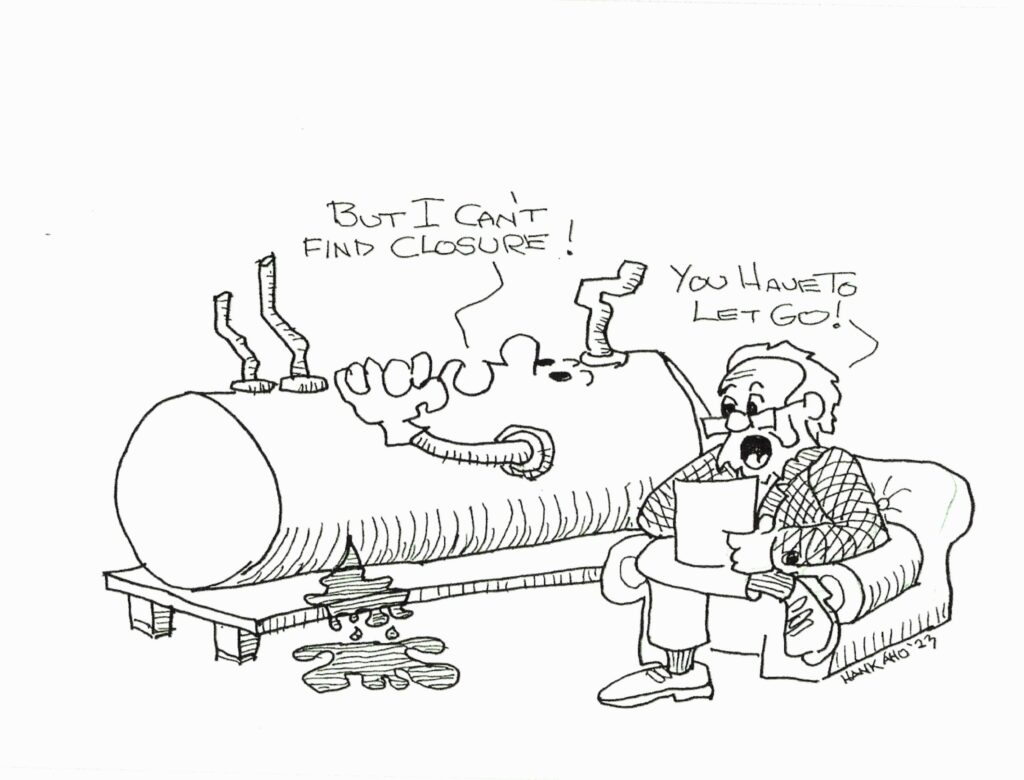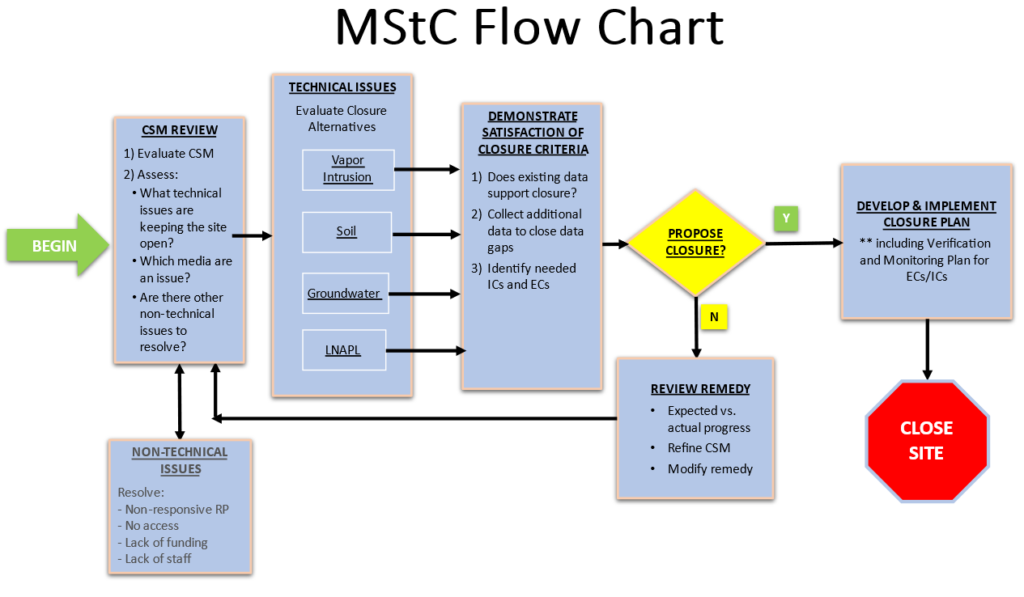Into the MStC – Developing A New Standard for Moving Petroleum Release Sites to Closure

UST cleanup programs have made remarkable progress over the last 34 years and our mission is as crucial now as it was in 1989. We have completed more than 512,000 UST cleanups and have learned a lot in the process. Keeping our drinking water safe is a primary concern. About half of our active UST facilities and ongoing cleanups are in source water protection areas. Further, an estimated 400,000 private water wells are located within 1,500 feet of an UST release. An additional concern is preventing petroleum vapors from entering confined spaces and indoor air.

Approximately 58,000 known cleanups remain in our program backlog. New, and newly discovered releases will eventually be found at some of the 192,000 operating UST facilities, particularly as these facilities close or replace their USTs. While most newly discovered UST releases are addressed and resolved promptly, a percentage are likely to pose technical and administrative challenges. It is going to take our best collective efforts for the cleanup programs to keep up with the workload.
The question before us today is — can we make changes in the cleanup process to improve protection of human health and the environment and at the same time provide a clear and consistent pathway to get cleanups completed and closed?
Early Days
When considering a change, I like to look back at where we have been and what we have learned. I first got into petroleum UST cleanups in the 1980’s. Back then, the prevailing conceptual model of contaminant spread assumed that:
- Contaminants are released and spread underground following the groundwater and will eventually reach drinking water wells and surface water bodies.
- As contaminants move with the groundwater they spread out through dispersion and dilution.
In the early days of the UST program, some regulators tried to apply a single standard for what concentration of petroleum in the ground posed a threat, but we quickly realized that every release site is different. A small release in some settings could cause a lot of problems while large releases at other sites would not harm human health and the environment. It became apparent that we needed cleanup goals that were tailored to the specific circumstances of each site.
Starting in the 1990s, the program employed simple conceptual models that considered the relationships between sources, pathways, and receptors. We developed back calculation models to determine how much source had to be removed to keep exposures to an acceptable level at the receptor well or body of water assuming dispersion and dilution of the petroleum. This approach was called risk-based corrective action (RBCA) or risk-based decision making. Some states adopted this approach for setting target cleanup goals, and it has proved very successful over the years. However, we knew that the risk-based approach was conservative because it did not consider biodegradation. In practice, at most sites we found that instead of dilute concentrations reaching exposure points once the risk-based cleanup targets were met, no measurable petroleum concentrations reached the exposure points.
Technical Leaps Forward – LNAPL and the Conceptual Site Model
Over the years, with lots of experience cleaning up petroleum UST releases and in-depth studies of large petroleum releases, we developed a much more sophisticated understanding of how petroleum releases behave underground. Several years ago, leading experts in petroleum contamination convened and updated a guide under the Interstate Technology & Regulatory Council called “Light Non Aqueous Phase Liquid (LNAPL) Site Management: LCSM Evolution, Decision Process and Remedial Technologies, LNAPL 3” or the LNAPL Update. This is an excellent guide on how petroleum behaves underground and provides new ways to approach releases.

Building on the source‐pathway‐receptor framework from the 1990s, as shown in Figure 2, we have learned that biodegradation occurs throughout the LNAPL, soil, and dissolved plume and begins soon after the petroleum is released into the ground. While the interior of the plume is generally starved of oxygen (anaerobic), petroleum is still degrading. The evolution of the contamination can be divided into three stages:
Stage 1. When the release first occurs, the LNAPL moves through the ground and the plume expands. It reaches a limit of horizontal movement relatively quickly. The rising and falling groundwater may spread it vertically over the first few seasons, but the footprint is set relatively quickly.
Stage 2. The dissolved plume also becomes stable, and the plume will reach its maximum length, and spread no further (Connor, et. al.[1] found that the benzene extended less than 425 feet in 90% of gasoline plumes). This is very different than we often see with chlorinated solvents where the plume can extend over much longer distances.
Stage 3. Over time, the contaminants will degrade, reducing the amount of petroleum in the ground and shrinking the footprint of the plume. This phenomenon is often referred to as natural attenuation or natural source-zone depletion.
We have also learned that over time, the remaining LNAPL will get trapped in the soil, becoming residual, and at many sites with measurable amounts of petroleum in monitoring wells, hydraulic recovery methods have limited effectiveness in removing the LNAPL.
The ITRC LNAPL-3 conceptual site model demonstrates that we can include the concept of LNAPL and plume stability when making decisions to resolve and close sites. LNAPL can be migrating (spreading laterally), mobile (able to spread up and down and accumulate in monitotring wells), or residual (trapped in the soil matrix). The key focus of assessment and corrective actions should be to understand whether LNAPL is migrating; decide whether utilized groundwater is affected by a release; and verify that no petroleum vapor intrusion is occurring or probable.
It takes specific data for each site to develop a conceptual model and to determine what needs to be done. The threat posed by a release at a particular site depends on the circumstances of the release, receptors, ground structure, and groundwater movement. If the release poses a threat, or if we cannot be certain that there is no threat, implementing agencies typically require corrective action to remove the source, break the pathway, or eliminate the exposure point.
Moving into the MStC
The LUST program (federal, state, tribal, and local) has come a long way, but we’ve got a lot of work ahead of us to turn our improved understanding of LUST sites into an actionable strategy for moving sites to closure (MStC). A task group of 73 members from all petroleum cleanup sectors is working to reimagine the corrective action process to safely move remediation projects to closure. We are developing MStC as a standard guide under the American Society for Testing and Materials (ASTM) process because it encourages consensus and full consideration of dissenting comments. ASTM hosted the development of the RBCA standard 30 years ago; however, this standard is different from RBCA in that we are developing alternative strategies for moving cleanups to closure as opposed to developing initial target cleanup goals. In addition, this standard does not presume the initial cleanup goals were developed using RBCA. We have been meeting for a year and have made significant progress toward a complete draft standard that can be balloted. Our plan is for the MStC guide to provide a decision framework for closing petroleum UST remediation projects based on the latest science and our decades of program experience.
As currently drafted, the MStC process, shown in Figure 3, begins with an evaluation of the conceptual site model and an assessment of what is keeping the corrective action from closing — whether it is a technical issue (e.g., high concentrations of contaminants in a monitoring well), or a non‐technical issue (e.g., getting site access for sampling).

The standard then divides the technical closure issues into four categories: LNAPL, groundwater, soil, and vapor. For each of these categories, the standard describes alternative criteria that could be used to demonstrate that the site is no longer a threat. The standard provides several alternative closure criteria so that the user has flexibility to choose one that best fits their site and available data. For each alternative closure criteria, the standard describes the data needed to demonstrate the criteria and the remaining uncertainties.
If the user decides to propose closure, the standard describes how to present the proposal and the closure plan. If the user decides not to propose closure, the standard describes how to review remedial progress, refine the conceptual site model, and modify the remedy or the remedial goals to get on a pathway to closure.
We plan to include examples in the appendices of the standard that provide examples of how the standard could be applied to various petroleum UST release scenarios. The appendices will also include background on the science that supports the various closure criteria included in the standard. The task group has made considerable progress, but we still have a lot of writing ahead of us and getting a complete standard through ASTM’s ballot process will take significant effort. If you are interested in participating in the task group, send me an email at Schruben.Thomas@epa.gov.
[1] “Review of Quantitative Surveys of the Length and Stability of MTBE, TBA, and Benzene Plumes in Groundwater at UST Sites”, Connor, et. al, Vol. 53, No. 2–Groundwater–March-April 2015
